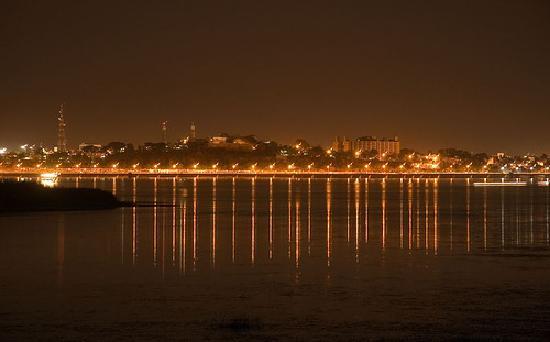One chilly winter evening in December 2014, I found myself in the august company of this Methuselah of sorts, who after years of constant wheedling had finally agreed to chat with me. For the first time I experienced a Bhopal that I had never seen before – one that remains unsullied even though the rest of the city is undergoing rapid remolding in an effort to keep up with changing times. This is a section that represents an era of iron-willed Begums who ruled the city with a flair that is hard to find even today.
My peregrinations were flagged off as I stepped into the rose pink edifice of Gauhar Mahal – a 19th century palace built for the first female ruler of Bhopal – Begum Qudsia. Against its moss-encased arches a handicrafts exhibition was in full swing. In the center of the main courtyard sat a dried up marble fountain wearing yellow stains of age. Around it, the air was thick with the sweet essence of rose, lotus and sandalwood attar originating from the open vials of a hijab clad lady whose ingenious advertising gimmick was proving quite effective in luring customers. Hand-painted silk scarves hung from makeshift displays, fluttering tantalizingly in a cool breeze and life-like figures carved in brass silently beckoned clamoring patrons.
The mise-en-scene was such that it transcended all borders of time, invoking images from when Bhopal was 200 years younger. I could almost spot the sparkling anklet of a lady-in-waiting just as she disappeared behind a carved column or hear the hoof-beats as patrolling soldiers returned from their nightly vigil. Through the torch-illuminated corridors of this very palace the aristocratic Begum, who shunned the purdah amongst other regressive traditions, must have once walked, pearls tinkling and silk and brocade robes swishing around. With a shopping bag overflowing with goodies and a head overflowing with sepia toned ideas, I returned home, excited about the prospect of exploring other jewels of Old Bhopal in the coming days.
As the nebulous rays of winter sunshine escorted in a new day, another 19th century relic patiently waited for me to come calling. Hidden behind a coat of white-wash, in the busy lanes of Royal Enclave, I found Sadar Manzil. The pearl white paint that was deemed suitable for the ancient structure by new age ministers is in-fact totally inefficacious in concealing its true age. Built during the reign of Bhopal’s fourth and final female ruler – Kaikhusrau Jahan Begum, the palatial building was used as a hall of public audience where the Begum convened with her subjects. Despite the seemingly mundane administrative work that went on within its walls, it is apparent that no stone was left unturned in its beautification. The proof of this can be seen in a series of decadent murals that decorate its domed ceilings. Through charcoal wisps of decimated cobwebs and a thick blanket of dust, one can still trace the beautiful patterns of blossoming buds, dewy leaves and curling stems on the walls.
Keeping up with its tradition, Sadar Manzil now houses government offices like those of the Municipal Corporation. As a result it has taken on the appearance of any other modern day government office in India. Every available inch of space bears towering stacks of old official files tied with pieces of frayed red string and brown with years of accumulated grime. Most corners and alcoves are encrusted with maroon spatters where scores of insouciant paan masticators over years have mercilessly regurgitated the contents of their mouths. Picking my way through haphazard rows of sealed Godrej almirahs, scurrying rats and piles of rubble, I made it to the terrace from where the Bhojtal or Upper Lake can be seen placidly stretched out in all its silvery grey glory. I can well imagine court poets of yore making use of this visage as inspiration for producing soul stirring poetry.
Breaking my fable-like journey for a cup of tea at the famous Raju Tea Stall at Sultania Road near Peer Gate was a revelation in itself. Who could have guessed that a seemingly footling tea stall which had innocuously elbowed its way between tightly packed hardware and kirana stores could serve the most succulent mawa jalebi and rabri, crisp pakodas and aromatic chai. Legend has it that despite its rather run-down veneer and common-man clientele, many an important government officials frequent it to get their regular fix of chai and snacks…….To be continued
Preeti Sharma is an MBA and dabbles with creative writing. She also blogs at www.preetisharma84.blogspot.com
.







You have successfully and beautifully revealed the mystery and history of this wonderful city. Since last 30 years it is remembered for the tragedy that struck the people of Bhopal in December 1984.